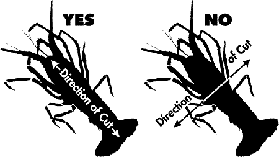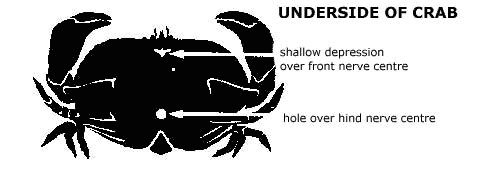
Humane harvesting of fish and crustaceans
Fin-fish
It is important to be able to apply humane dispatching methods to any fish that are to be harvested. Percussive stunning is considered a good approach provided it is done swiftly and delivered to the correct area.
Fish should be hit with a sharp blow to the head in the area just above the eyes (the area adjacent to the brain) using a special tool such as a heavy wooden handle or a priest. When applied correctly the fish’s gill covers should stop rhythmically moving and the eye should remain still. Fish should only be bled after the fish has been dispatched.
Small to medium-bodied, warm-water fish species may be dispatched using an ice slurry. The slurry should contain equal volumes of crushed ice and water. Check the temperature using a thermometer.
A fresh water slurry should be 0oC and a salt water slurry should be -4oC. Monitor the temperature and add more ice as needed. Place the fish in the slurry, avoiding contact between the fish and the ice where possible. Leave the fish in the bath for 20 minutes or for 10 minutes after breathing has ceased.
Crustaceans
In recent times ideas have changed about how to handle crustaceans in the restaurant and catering industries. Procedures causing pain or distress to crustaceans must be avoided.
Crustaceans used in restaurant and catering industries include lobsters, crabs, yabbies, marron, crayfish and Balmain bugs. People who handle these animals are responsible for ensuring the most humane methods are used when catching, transporting, housing and killing them.
Salt water/ice slurry method
It is recommended that all crustaceans are immersed in a salt water/ice slurry for a minimum of 20 minutes before boiling, broiling, pithing or cutting. This ensures the animal is immobilised before procedures that may cause pain are carried out.
The salt water/ice slurry is made by first filling a suitable container (such as an esky) with normal crushed ice, then adding salt water (sea water salinity). The ratio of normal ice to salt water should be 3:1, which will give the consistency of wet concrete and a temperature of –1°C. It is important that enough ice is provided to maintain the temperature of the slurry.
Rapid destruction of nerve centres
If the above method is not practical it is suggested that the central nerves be quickly destroyed.
Wherever possible, however, it is recommended that rapid destruction of the nerve centres be done after a 20 minute immersion in salt water/ice slurry.
Lobsters
Lobsters have a chain of nerve centres running down the central length (longitudinal midline) of the animal. For sashimi (raw) and broiling (grilling) methods these centres should be destroyed by rapidly cutting through the longitudinal midline (lengthways) of the lobster with a large sharp knife.

Two cuts should be made:
- start in the midline near the tail/chest junction and cut towards the head;
- from the midline near the tail/chest junction, cut towards the tail.
A mallet should be used to force the knife quickly through the animal. After cutting in half (lengthways) the chain of nerve centres at the front end (chest and head) of the lobster should be rapidly removed.
This procedure should not take more than 10 seconds and should only be done by a skilled operator.
Crabs

Crabs have two main nerve centres: at the middle front and rear of the animal.
When time is limited, crabs may be placed in a salt water/ice slurry for a few minutes, to stop movement, before:
- rapid destruction of the front and rear nerve centres with a thick pointed, pithing instrument, or
- rapid removal of the carapace (top shell) and destruction to the front and rear nerve centres.
These procedures should not take more than 10 seconds and should only be done by a skilled operator.
Unacceptable methods
The following procedures are not acceptable because they have the potential to cause prolonged or avoidable pain or distress to crustaceans:
- transverse sectioning, of lobsters (i.e., separating the head and chest from the tail of the lobster without first destroying all the nerve centres);
- cutting crabs into sections before destroying the front and rear nerve centres;
- boiling crustaceans before immersing them in a salt water/ice slurry for a minimum of 20 minutes.
Transportation and housing
It makes good business sense to transport and house crustaceans in conditions that do not cause stress, as this helps ensure the animals are kept healthy. Healthy animals are especially important to the retailer who is dealing with expensive crustaceans.
During transport and transfer, avoid rapid changes in variables, such as temperature and water quality, as these can cause stress.
Sources of stress during housing include:
- poor water temperature control
- inadequate aeration
- poor or unsuitable water quality
- overcrowding
- incompatible species kept together.
Signs of unsatisfactory conditions in holding tanks include:
- foam on the water surface
- cloudy water
- slime and algal growth on the walls of the tank.
Methods to help maintain good conditions in holding tanks include;
- providing water purification and filtration systems
- using suitable water-testing procedures.
These guidelines for crustaceans have been prepared by the Animal Welfare Advisory Council, based on the Council’s understanding of the best information available at the time of drafting. The input and cooperation of the Restaurant and Catering Association of NSW is gratefully acknowledged.
Further information
Contact the NSW DPI Animal Welfare Unit.

